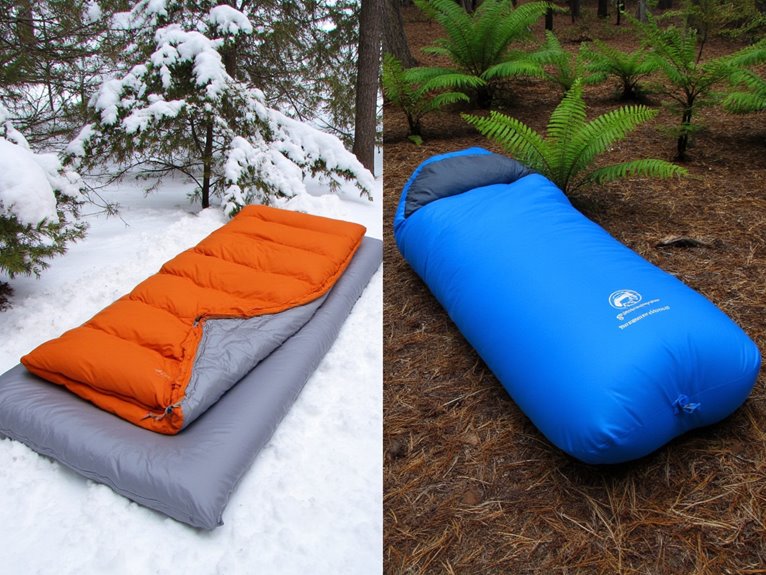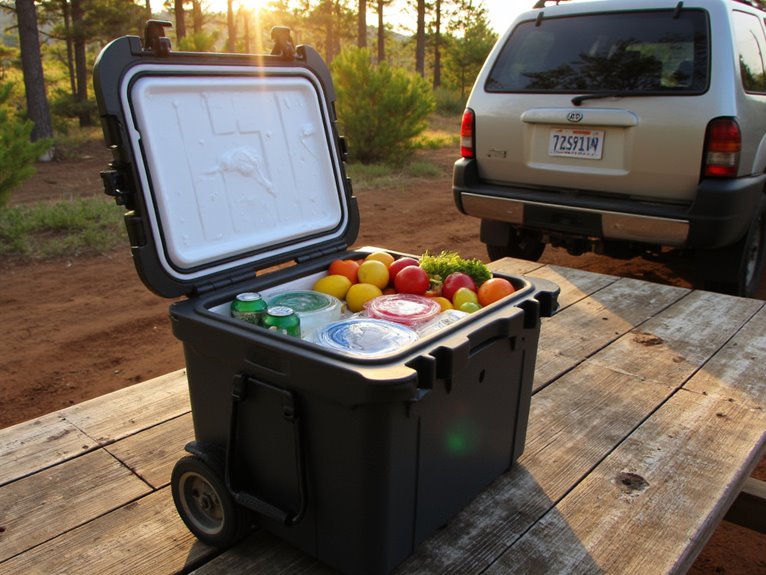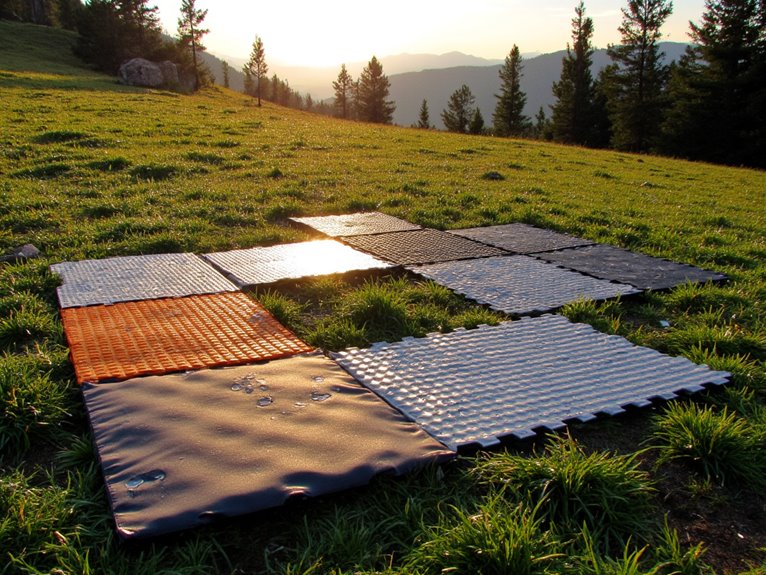Do I Need a Sleeping Pad
You absolutely need a sleeping pad because the ground conducts heat away from your body up to 25 times faster than air, making even the warmest sleeping bag ineffective without proper insulation. A quality pad provides essential thermal protection through R-value ratings—ranging from 2.0 for warm weather to 5.5+ for winter conditions—while offering vital cushioning on uneven terrain. The investment proves worthwhile when you discover how pad selection impacts your entire outdoor experience.
We are supported by our audience. When you purchase through links on our site, we may earn an affiliate commission, at no extra cost for you. Learn more. Last update on 5th December 2025 / Images from Amazon Product Advertising API.
Notable Insights
- Sleeping pads prevent up to 25 times more heat loss than air by blocking conductive transfer to cold ground.
- Ground contact compresses sleeping bag insulation and creates a thermal sink that pulls warmth from your body overnight.
- Pads provide essential cushioning on hard, uneven terrain with 2+ inches thickness recommended for comfortable sleep.
- Different camping styles require specific features: backpackers need lightweight options while winter campers need R-values of 5.0+.
- Without proper ground insulation, you risk hypothermia, poor sleep quality, and significantly compromised camping comfort regardless of season.
Why Ground Insulation Matters for Outdoor Sleep
When you sleep directly on the ground, your body loses heat through conductive transfer at a rate up to 25 times faster than through air.
Ground temperature drops considerably at night, creating a thermal sink that pulls warmth from your body. The earth’s high thermal conductivity means heat flows rapidly away from contact points, overwhelming your body’s ability to generate replacement warmth.
This heat loss compromises sleeping bag performance since compressed insulation beneath you provides minimal heat retention. A high R-value sleeping pad provides essential insulation barriers that dramatically reduce conductive heat transfer to cold ground surfaces.
Without proper ground insulation, hypothermia risk increases dramatically as your core temperature drops. Cold exposure causes sleep disturbance, reducing recovery time between activities.
Ground contact also exposes you to moisture, further degrading insulation effectiveness and comfort levels throughout the night. Modern sleeping pads often incorporate reflective barriers that reflect radiant heat back to your body rather than absorbing it into the ground.
Quality sleeping pads with 40D-50D nylon construction provide additional durability while maintaining essential thermal protection against the elements.
Understanding R-Values and Thermal Protection

Ground insulation effectiveness gets measured through a standardized rating system called R-value. This metric quantifies thermal resistance, indicating how well your pad prevents heat transfer from your body to cold ground.
The R value significance lies in its linear scale—a pad with R-value 4.0 provides twice the insulation of one rated 2.0.
Understanding R-value’s linear scale empowers smart gear choices—doubling the rating means doubling your thermal protection against cold ground.
R-values guide your gear selection:
- R-values below 2.0: Warm weather camping only
- R-values 2.0-3.9: Cool weather conditions
- R-values 4.0-5.4: Cold weather protection
- R-values 5.5+: Extreme cold environments
- Multiple pads: R-values add together when stacked
Standardized testing (ASTM F3340-22) guarantees consistent ratings across brands. Prior to 2020, inconsistent testing methods across different manufacturers made it difficult to accurately compare R-values between brands.
Higher R-values result from advanced materials like closed-cell foam, reflective barriers, and synthetic insulation that minimize conductive heat loss. Closed-cell foam pads provide consistent insulation and are particularly durable for extended outdoor use. Pads with 4-5 inches thickness offer optimal support and comfort by creating more distance between your body and the cold ground.
Comfort Benefits on Uneven Terrain
When you’re camping on rocky or root-covered ground, a sleeping pad creates an essential cushioning layer between your body and hard surfaces.
This barrier greatly reduces pressure points that would otherwise dig into your hips, shoulders, and other bony prominences throughout the night.
Pads with at least two inches of thickness provide the most effective cushioning, transforming uncomfortable terrain into a supportable sleeping surface. Thickness over 3 inches is suggested for ergonomic comfort, which helps ensure better support during sleep.
In freezing conditions, soft surfaces like pine boughs and leaf litter provide added warmth and comfort beneath your pad.
However, inflatable pads like the Thermarest XLite can slide on slopes, creating additional comfort challenges even on cushioned surfaces.
Cushioning Hard Ground Surfaces
Although rocks, roots, and uneven dirt create pressure points that disrupt sleep, a quality sleeping pad transforms uncomfortable terrain into a manageable sleeping surface.
Pads over 2 inches thick effectively mask ground irregularities by distributing your body weight across the surface. This cushioning prevents painful pressure points that occur when you’re lying directly on hard ground.
Proper pad selection depends on your specific terrain adaptability needs:
- Air pads provide maximum cushioning with excellent pressure distribution
- Self-inflating pads offer superior stability on rocky surfaces
- Thicker designs (3+ inches) handle the most challenging ground conditions
- Closed-cell foam delivers reliable cushioning without puncture risks
- Surface materials affect durability when used on abrasive terrain
Thicker pads sacrifice pack weight but deliver considerably better comfort on unforgiving surfaces. Additionally, combining multiple pads can significantly increase your R-value for enhanced insulation performance. Testing sleeping pads at local outdoor stores helps ensure you select the right thickness and design for your typical camping terrain.
Reducing Pressure Points
Beyond simply smoothing out rocky terrain, sleeping pads excel at eliminating the specific pressure points that cause discomfort and restless nights on uneven ground. Your hips and shoulders bear concentrated weight when lying on hard surfaces. Padding up to 4.6 inches thick provides essential pressure distribution across these vulnerable areas.
Side sleepers particularly benefit from this enhanced weight management system. Inflatable pads offer fine-tuning capabilities for ideal comfort. You can adjust pressure zones to soften areas under bony prominences while maintaining support elsewhere. Multi-chamber designs enable separate inflation levels for different body regions.
Stretch-knit polyester fabric conforms closely to your body shape, spreading weight evenly. Air-sprung cells provide superior pressure distribution and stability, making them especially effective for side sleepers who need targeted support. Adding a closed-cell foam layer beneath your inflatable pad further improves pressure distribution and creates redundant cushioning for maximum comfort. Vertical baffles provide additional structural support that enhances pressure point relief across the entire sleeping surface.
Types of Sleeping Pads and Their Features

Three primary types of sleeping pads dominate the outdoor gear market, each designed with distinct construction methods and performance characteristics. Understanding these differences helps you select the best pad for your specific needs.
Air pad features include exceptional compactness and lightweight design. They’re ultraportable, packing down to the size of a Nalgene bottle. However, puncture risk requires carrying repair patches.
Self inflating advantages combine air and foam construction for superior insulation and enhanced durability. They’re heavier than air pads but offer excellent versatility across camping conditions.
Side sleepers specifically require 3 to 5 inches of thickness to properly support hips and shoulders while maintaining spinal alignment.
- Air pads provide maximum thickness for side sleepers
- Self-inflating pads balance comfort with insulation performance
- Closed-cell foam pads eliminate deflation risks entirely
- Higher R-values indicate better cold weather protection
- Bonded insulation techniques enhance warmth retention capabilities
Choosing Based on Your Camping Style

Your camping style directly determines which sleeping pad features matter most for your adventures.
Car campers can prioritize thick, comfortable pads since weight isn’t a concern, while backpackers must balance comfort against every ounce in their pack.
Winter camping requires high R-value insulation regardless of your camping method, as ground temperatures can drain body heat faster than air temperatures drop.
Ultralight sleeping pads typically weigh between 15.9 oz and 20 oz, making them ideal for long-distance hikers who need to minimize pack weight without sacrificing essential comfort.
Car Camping Comfort Options
When car camping becomes your preferred outdoor escape, selecting the right sleeping pad depends entirely on your specific camping approach and comfort priorities.
You’ll find sleeping pad options ranging from basic closed-cell foam to luxurious self-inflating models that rival home mattresses.
Car camping allows you to prioritize camping comfort over weight restrictions.
Consider these essential factors:
- Thickness levels – 2-6 inches determine cushioning quality
- R-value ratings – 1.0-6.6 range for temperature insulation needs
- Pad dimensions – Single, double, or family-sized configurations
- Material construction – Open-cell foam, air chambers, or hybrid designs
- Setup complexity – Self-inflating versus manual pump requirements
High-end options like the NEMO Roamer ($249.95) offer superior durability and comfort.
Budget-friendly alternatives under $300 provide adequate performance for casual campers without compromising essential features.
Backpacking Weight Considerations
Unlike car camping’s weight freedom, backpacking demands careful consideration of every ounce you’ll carry on the trail. Closed-cell foam pads offer the lightest option at 10–18 ounces, while inflatable pads range from 12–32 ounces depending on features. Self-inflating pads typically exceed one pound, making them less suitable for ultralight approaches.
Length considerably impacts weight. Short 3/4-length pads (47–48 inches) save considerable weight compared to regular 72-inch models. Mummy shapes reduce material versus rectangular designs. For multi-day packing, every ounce matters as fatigue accumulates over miles.
Consider gear sharing with partners—two-person pads weigh less than separate individual pads. Width increases comfort but adds weight and bulk.
Standard 20-inch widths balance portability with adequate sleeping space for most backpackers pursuing weight-conscious trail experiences.
Winter Camping Insulation Needs
While three-season camping allows for lighter insulation systems, winter conditions demand sleeping pads with considerably higher thermal resistance to prevent dangerous heat loss through snow and frozen ground.
You’ll need an R-value of at least 5.0 for adequate heat retention in winter environments. Ground temperatures below freezing pull warmth from your body exponentially faster than moderate conditions.
Consider these winter insulation strategies:
- Stack two pads (closed-cell foam plus self-inflating) for redundancy and enhanced R-value
- Choose winter-specific pads rated R-4 to R-8 rather than summer models
- Layer strategically with foam pad against ground, air pad on top
- Test R value comparison at home before your trip
- Carry repair kits for inflatable pads to prevent insulation failure
Single high-R pads work, but dual-pad systems offer backup protection if one fails.
Winter Vs Three-Season Requirements

The ground beneath your sleeping bag acts like a thermal sponge, drawing heat away from your body at vastly different rates depending on the season and conditions you’re camping in.
Winter camping demands an R-value of at least 5, while three-season conditions require only a minimum R-value of 2. This fundamental difference drives your sleeping pad materials selection and seasonal camping strategies.
Winter pads incorporate heat-reflecting layers and specialized insulation to combat snow and ice. The NeoAir XTherm NXT delivers an R-value of 6.9 for extreme conditions.
Three-season pads prioritize versatility across dirt, rock, and grass surfaces using foam and air constructions. You can stack two pads to achieve higher R-values when needed.
Winter setups often include backup foam pads for reliability.
Weight and Packability Considerations

Every ounce matters when you’re carrying your shelter system for miles, and sleeping pads present one of the most crucial weight versus comfort trade-offs in your gear selection.
Ultralight inflatable pads like the Therm-a-Rest NeoAir XLite NXT weigh just 13 ounces while providing excellent insulation. Heavier options such as the NeoLoft weigh 1 lb 8.9 oz but offer superior cushioning.
Weight trade offs become critical when considering your priorities.
Packability options greatly impact your gear organization:
- Mummy-shaped pads reduce packed volume compared to rectangular designs
- Short 47-48 inch pads save weight but require supplemental leg insulation
- Thin 30-denier fabrics improve packability but increase puncture risk
- Closed-cell foam pads offer the lightest weight option
- Two-person pads can reduce overall weight for couples
Choose based on your specific comfort requirements and pack weight limits.
Sleep Quality Impact on Your Adventure
Poor sleep quality doesn’t just leave you groggy the next morning—it can derail your entire adventure and compromise your safety on the trail.
Without proper rest, your reaction times slow and decision-making abilities deteriorate. Your body needs REM and deep sleep stages for recovery after physical exertion.
Adventure environments naturally disrupt sleep patterns through temperature fluctuations, ground irregularities, and environmental noise.
These factors fragment your sleep, reducing restorative stages vital for muscle recovery. Poor sleep performance compounds over multiple days, creating a cascade of fatigue that affects your physical capabilities and mental alertness.
A quality sleeping pad addresses these challenges by providing pressure relief and insulation.
This allows your body to complete essential sleep cycles, maintaining the performance levels necessary for safe outdoor adventures.
Making the Right Investment Decision
When should you invest in a quality sleeping pad, and how much should you spend? Market trends indicate robust growth in the sleeping pad industry, with values reaching $2.5 billion by 2033. Your investment strategies should align with usage frequency and specific needs.
Consider these investment factors:
- Budget range: Entry-level pads cost $30-60, premium models range $100-200
- Usage frequency: Weekend campers need different specs than frequent backpackers
- Weight requirements: Ultralight pads cost more but save ounces for long-distance hiking
- R-value needs: Higher insulation ratings ($80-150) essential for cold-weather camping
- Durability expectations: Premium materials justify higher costs for frequent use
The market’s 6.5% CAGR reflects solid demand growth. Quality pads offer better materials, enhanced insulation properties, and improved durability.
Your investment should match your adventure frequency and comfort requirements.
Frequently Asked Questions
Can I Use a Regular Mattress or Yoga Mat Instead of a Sleeping Pad?
You shouldn’t substitute regular mattresses or yoga mats for sleeping pads when camping.
Regular mattresses create significant mattress drawbacks: they’re heavy, bulky, and lack insulation properties needed outdoors. You’ll experience heat loss on cold ground without proper R-values.
Yoga mat comfort proves inadequate for sleeping, offering minimal padding and zero insulation.
You need sleeping pads’ specialized design for portability, warmth retention, and durability in outdoor conditions.
How Do I Repair a Punctured Inflatable Sleeping Pad in the Field?
You’ll need to locate the puncture first using soapy water to spot bubbles forming at leak points.
Clean the area thoroughly with alcohol wipes and let it dry completely.
Most inflatable pads include patch kits with adhesive patches. Apply the patch firmly over the puncture, ensuring complete coverage.
For field repairs without kits, tenacious tape works as a temporary solution. Allow ten minutes curing time before reinflating to test effectiveness.
Do Sleeping Pads Work With Hammock Camping or Just Ground Camping?
Sleeping pads work effectively with hammock camping, not just ground camping.
You’ll gain significant hammock comfort by placing pads inside your hammock to create a flatter sleeping surface and reduce the natural curve.
Critical insulation factors include the pad’s R-value and thickness, as hammocks offer minimal cold protection underneath.
Pads provide versatile warmth and support, though they may shift during sleep and require positioning adjustments for ideal performance.
What’s the Average Lifespan of Different Types of Sleeping Pads?
You’ll find closed-cell foam pads last longest, typically 5-10 years with proper care.
Longevity factors include material thickness and usage conditions.
Self-inflating pads average 3-5 years before seam failures occur.
Air pads have the shortest lifespan at 2-4 years due to puncture vulnerability.
Material comparison shows foam’s inherent durability versus synthetic insulation compression in inflatables.
Proper storage and maintenance greatly extend these ranges across all pad types.
Are There Sleeping Pads Specifically Designed for Side Sleepers Versus Back Sleepers?
Side sleeper pads feature greater thickness and targeted pressure point relief compared to back sleeper pads.
You’ll find side sleeper pads typically offer 3.5-4.6 inches of thickness to cushion hips and shoulders.
Back sleeper pads can be thinner since your weight distributes more evenly.
Side sleeper pads also incorporate higher R-values for insulation and anti-slip features to prevent rolling off during sleep position changes.
On a final note
You absolutely need a sleeping pad for any outdoor adventure. Ground contact steals your body heat through conduction, making sleep uncomfortable and potentially dangerous. Your pad’s R-value must match seasonal conditions—minimum 2.0 for summer, 4.0+ for winter. Weight, packability, and durability factor into your choice, but thermal protection remains non-negotiable. Don’t compromise on this essential gear. Your sleep quality directly impacts safety, decision-making, and overall adventure success.




